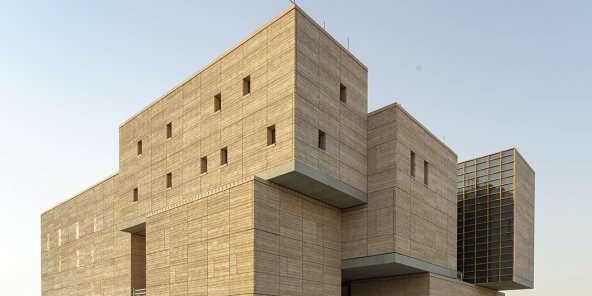Source: Jeune Afrique (Sept 2021)
As a result of climate change and pollution, entire neighborhoods and cities across the continent are doomed to disappear. A new vision of African urban planning is needed.
Sebha will disappear. The capital of Libyan Fezzan, rich in hydrocarbons, had nevertheless become the largest agglomeration in the Sahara. For years, it has seen the convergence of public and private capital, and migrants by the thousands. Subject to very strong demographic pressure, the city of sands is doomed today. Sooner or later, the lack of water will empty it of its inhabitants. It will be necessary to return its territory to nature.
Sebha is not an isolated case. Everywhere, neighborhoods and towns are on the verge of disappearing. Here, because of the rising waters, there, the galloping desertification, mega-fires, or even repeated cyclones. These are the devastating and unprecedented consequences of climate change, of course, that the latest IPCC report has just recalled, but not only. By participating in toxic production systems, we have degraded nature and climates. At the same time, since the industrial era, we have massively adhered to this crazy fantasy of the limitless city, capable of absorbing more and more inhabitants, without questioning its ability to meet their basic needs.
Absolute urgency
Look at Los Angeles: it’s been a long time since the first city of California did not have enough water resources. She brings her from the Sierra Nevada, nearly 600 km away. Even in one of the richest regions of the world, this infrastructure, which doesn’t care about borders and distances, is running out of steam. Los Angeles has suffered from water cuts for two decades; a problem out of step with the standard of living of its inhabitants.
To read Should Africa remain poor for the planet to breathe? by François Soudan
In the rich countries, the system cracks more quickly than one thought. In Africa, it is the absolute urgency. It is the last continent to urbanize, and the one that does it the fastest, without a state structure capable of financing the infrastructure that this implies. Between high birth rate and rural exodus, it is in Africa that 86 of the 100 fastest growing cities in the world are located. At least 79 of them – including 15 capitals! – face extreme risks due to climate change.
Urban hell
The 13.2 million inhabitants of Kinshasa, the capital of the DRC, are already regularly victims of floods. They will be twice as many in 2035. In Ethiopia, the number of city dwellers will increase from 24 to 74 million in the next three decades. The Egyptian urban population will then reach 85 million inhabitants, against 43 million today. To the point of pushing the authorities to create a new capital to relieve the urban hell of Cairo.
How can we provide housing and equipment, roads and transport, drinking water and sanitation at such a sustained rate? It’s impossible. Tensions for access to water, energy or telecommunications will worsen as cities continue to have needs that exceed their territorial production capacities. Conflicts are inevitable. We are headed for disaster.
The reflection must be reversed, to find a balance between population, resources and territory
Unless we radically change the way we construct the world. In Africa as elsewhere, that means first of all to end the illusion of the limitless city. Some, like Sebha, will have to be abandoned to nature, and new ones will have to be built, by the thousands. But the reflection must be reversed, to find a balance between populations, resources and territories. The new city must be sized, limited by its own resources: if such a territory can provide water and energy for 50,000 people, then the future city must not exceed this size.
Relearn to be a nomad
To do this, we must reconnect with the visible infrastructures of the past, which were part of the landscape, thus calling for collective governance. This was the case with the Roman aqueducts, but also with the Agdal basins, which incorporated urban agriculture, or even the wells located in each district, as still today in Venice. We are trying today in Morocco, with the creation of the town of Mazagan, near El-Jadida, which we already know should not house more than 200,000 inhabitants.
To read Sub-Saharan Africa: is there a market for “sustainable constructions”?
The consequences of climate change, demographic pressure and rampant urbanization leave us no choice: Africa must be the scene of the reinvention of the city in the 21st century. And for that, it is urgent that it again become a laboratory for architectural and urban experimentation, with all the more legitimacy as it will no longer be, as in the past, a colonial laboratory.
If Africa continues to tackle urban planning models thought out elsewhere, without a critical dimension, it is heading for chaos
On the contrary, it is necessary to convene what Africa is capable of offering to the world, through organizational methods, traditional management of resources or even the use of materials that have fallen into oblivion. This kind of experiment is, for example, the raison d’être of the Moroccan Pavilion at the Dubai World Expo 2020. Built in raw earth, the building rises to 34 meters, an unprecedented height. More durable than concrete, raw earth, an African material par excellence, also makes it possible to do a large part of without air conditioning in one of the hottest places on earth.
If Africa continues to tackle urban planning models thought out elsewhere, without a critical dimension, it is heading for chaos. It is also necessary, in this field, to decolonize thought, and to imagine collective organizations which will allow us to adapt to the great displacements which climate change already imposes on us. It is in Africa that we can relearn how to be nomads, so as not to become refugees.





Leave A Comment